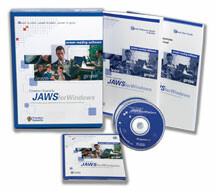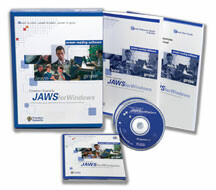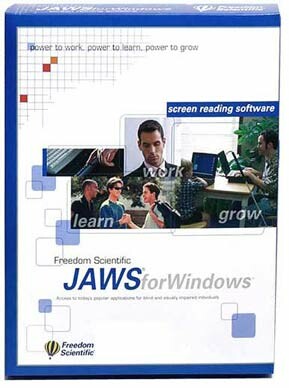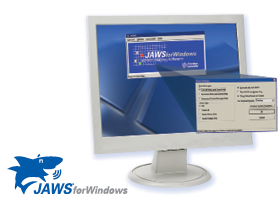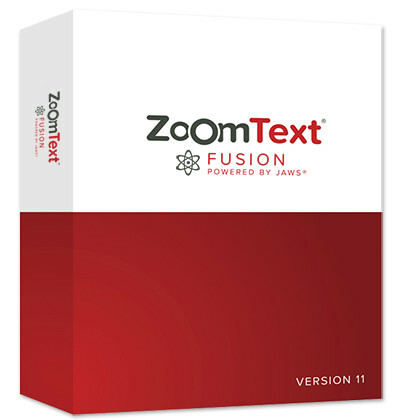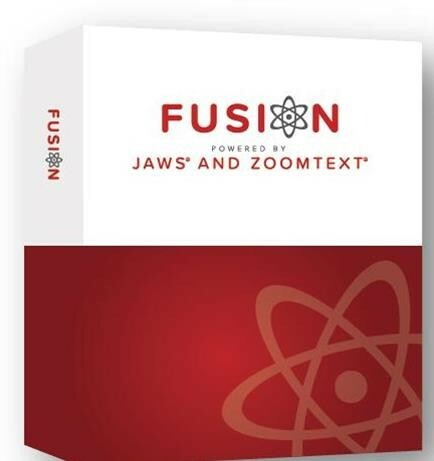JAWS Screen Reader – Professional Edition
$1,475.00
All software purchases are available in digital download format only – per the manufacturer. We no longer ship a CD-Rom.
Need Help?
JAWS – The World’s Most Popular Windows Screen Reading Software
JAWS, Job Access With Speech, is the world’s most popular screen reading software, developed for computer users whose vision loss prevents them from seeing screen content or navigating with a mouse. JAWS provides speech and Braille output for the most popular computer applications on your PC. You will be able to navigate the Internet, write a document, read an email, and create presentations from your office, remote desktop, or from home.
What is a screen reader?
A screen reader is a software program that enables a blind or visually impaired user to read the text that is displayed on the computer screen with a speech synthesizer or braille display. JAWS, Job Access With Speech, is the world’s most popular screen reader, developed for computer users whose vision loss prevents them from seeing screen content or navigating with a mouse. JAWS provides speech and braille output for the most popular computer applications on your PC..
- Read documents. emails, websites, and apps
- Easily navigate with your mouse
- Scan and read all of your documents, including PDF
- Fill out web forms with ease
- Easy to use with Daisy formatted basic training
- Save time with Skim Reading and Text Analyzer
- Surf the net with web browsing keystrokes
Features
- Two multi-lingual synthesizers: Eloquence and Vocalizer Expressive
- Includes drivers for all popular Braille displays
- Convenient OCR feature for image files or inaccessible PDF documents
- Picture Smart service to recognize images
- Voice Assistant to issue infrequently used commands
- Supports PEARL Camera for direct access to print documents or books
- Built-in free DAISY Player and full set of DAISY-formatted basic training books
- Works with Microsoft Office, Google Docs, Chrome, Edge, Firefox, and much more
- Supports Windows® 11, Windows 10, Windows Server® 2019, and Windows Server 2016
- Become more efficient with Skim Reading and Text Analyzer
- Compatible with ZoomText, Fusion, and OpenBook Scanning and Reading Software
Advanced Features
- JAWS Tandem Center is available for free to help with support and training
- Optional support for Tandem Direct, Citrix, Terminal Services, and Remote Desktop
- Powerful scripting language to customize the user experience on any application
- Kiosk support available
Software for Business
Take advantage of working with the leading company offering both Software and Hardware products for visually impaired users worldwide. These products are designed and tested to install and work together providing all your software needs from one provider. And when it comes to support, our distribution channel has years of experience, ensuring you get fast and accurate support in selecting and supporting your products.
Perpetual licenses are available for all our software titles – JAWS for Screen Reading, ZoomText and Fusion for Screen Magnification, and OpenBook for Scanning and Reading.
Choose between either single-user licenses or multi-user licenses, which utilize license servers to easily distribute software access throughout the organization. Add support for Citrix, VMware Horizon, and Remote Desktop, which are essential for environments that require users to access remote servers.
Always include the Software Maintenance Agreement (SMA) to maintain your Perpetual software with access to future updates and upgrades. As the applications used by consumers continue to change, it is critical to maintain your Access Technology License as well.
JAWS 2024 – March 2024 Release Notes
Picture Smart AI
When you’re navigating through digital content, you may come across images, graphs, and other visuals lacking descriptions, which can pose challenges in comprehending the information they convey. Introduced in 2019, the JAWS Picture Smart feature enables users to submit images for analysis through a layered keystroke. The description of the image is then presented in the JAWS Results Viewer window. For instance, by activating the Picture Smart layer with INSERT+SPACEBAR, P, users can utilize keys like F or C to describe images in File Explorer or on social media platforms like Facebook, respectively. For a comprehensive list of commands, one can press INSERT+SPACEBAR, P, QUESTION MARK.
Picture Smart AI marks a groundbreaking advancement over the conventional Picture Smart feature. By integrating cutting-edge artificial intelligence (AI) technologies from platforms such as Chat GPT by OpenAI and Gemini by Google, users can now delve into a whole new realm of accessibility to graphical content. While retaining the familiar accessibility pathway, Picture Smart AI offers enriched and detailed visual descriptions that astound users with their depth and clarity.
To illustrate the stark contrast in description detail, several example photos are provided alongside descriptions generated by both the existing Picture Smart and the new Picture Smart AI. Users can also explore this feature firsthand by selecting an image and pressing INSERT+SPACEBAR, P, C.
- Current Picture Smart Sample Description
- Caption is a group of people sitting on a beach. These tags describe the photo: beach, clothing, girl, group, human face, outdoor, people, person, sky, woman. These tags probably describe the photo: fun, sitting, summer, vacation, water. This tag possibly describes the photo: ground.
- Picture Smart AI Sample Short Description
- The image shows a group of six friends sitting on the beach. They are all smiling and laughing, and some of them are singing. One of them is playing the guitar. The sun is setting in the background, and the waves are crashing on the shore.
- Picture Smart AI Sample Long Description
- The image depicts a group of friends enjoying themselves on a beach at what appears to be sunset due to the warm, golden lighting. There are five individuals in the foreground, with one more partially seen in the background. The group is casually dressed in summer attire and seems to be engaged in a lively and joyful conversation.
In the left part of the image, there’s a man sitting on the sand, wearing a light blue button-up shirt and smiling broadly, evidently amused by the conversation. To his right, a woman is laughing heartily, her head tossed back and her hands raised—she’s wearing a yellow top. - Centered in the image, another woman is smiling and appears to be sharing a moment of enjoyment with the man on her left; she has her arm extended as if she is pointing at something or someone outside the frame. Turning clockwise, the next woman is in profile and not fully visible, she’s wearing a red and blue checked shirt, and seems engaged with the person beside her.
On the right side, another person is mostly turned away from the camera, wearing a white garment that could be a sweater or jacket; this individual appears to be looking back towards the others with a smile.
The beach setting provides a tranquil background with the ocean meeting the horizon. The mood is upbeat and the image exudes a sense of friendship, relaxation, and the simple joys of life. There’s a harmonious mix of motion and stillness, with some individuals in mid-gesture, which adds to the dynamic of a candid and spontaneous moment.
- The image depicts a group of friends enjoying themselves on a beach at what appears to be sunset due to the warm, golden lighting. There are five individuals in the foreground, with one more partially seen in the background. The group is casually dressed in summer attire and seems to be engaged in a lively and joyful conversation.
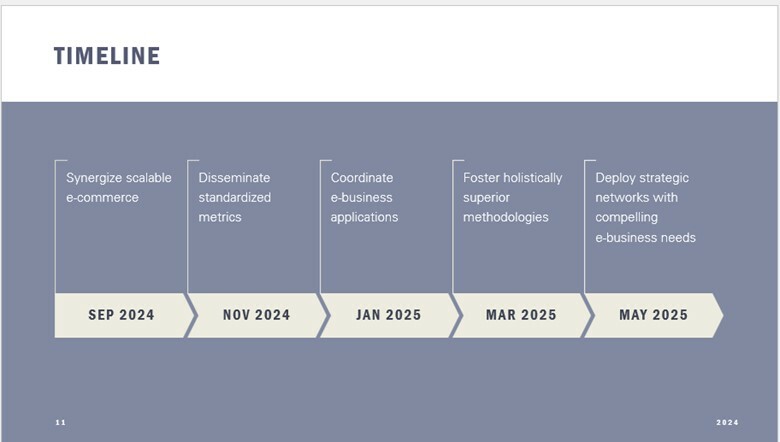
- Current Picture Smart Sample Description
- Caption is the timeline. These tags describe the photo: display, font, screenshot, text. These tags probably describe the photo: diagram, number.
- Picture Smart AI Sample Short Description
- The image is a timeline that spans from September 2024 to May 2025. It is divided into 5 sections, each with a different task and deadline. The tasks are as follows:
– September 2024: Synergize scalable e-commerce
– November 2024: Disseminate standardized metrics
– January 2025: Coordinate e-business applications
– March 2025: Foster holistically superior methodologies
– May 2025: Deploy strategic networks with compelling e-business needs
- The image is a timeline that spans from September 2024 to May 2025. It is divided into 5 sections, each with a different task and deadline. The tasks are as follows:
- Picture Smart AI Sample Long Description
- The image you provided is of a slide with a title “TIMELINE” at the top center. Below the title is a horizontal timeline graphic that spans from September 2024 to May 2025. The timeline is divided into five sections, each with a designated month and year, and an associated objective:
1. “SEP 2024” with the objective “Synergize scalable e-commerce”
2. “NOV 2024” with the objective “Disseminate standardized metrics”
3. “JAN 2025” with the objective “Coordinate e-business applications”
4. “MAR 2025” with the objective “Foster holistically superior methodologies”
5. “MAY 2025” with the objective “Deploy strategic networks with compelling e-business needs”
Each section is represented by an arrow pointing to the right that starts from the month and extends to the right with the objective contained in the body of the arrow. The colors of the image are mostly shades of blue and grey, with the timeline graphic against a lighter background. At the bottom right corner, there’s a page number or slide number indicated by “11,” and just above it, the year “2024” is written as a note. The overall aesthetic is professional and likely part of a business presentation.
- The image you provided is of a slide with a title “TIMELINE” at the top center. Below the title is a horizontal timeline graphic that spans from September 2024 to May 2025. The timeline is divided into five sections, each with a designated month and year, and an associated objective:
Picture Smart AI is currently available as an Early Adopter Program feature. We encourage you to try it and provide feedback using the “Send Feedback” form that is available in the Early Adopter Program dialog box.
To enable Picture Smart AI, do the following:
- In the JAWS Options menu, choose Early Adopter Program.
- Select Picture Smart with Generative AI.
Note: If you clear the check box, you return to the traditional Picture Smart functionality.
- Select OK and restart the software.
When submitting an image, Picture Smart AI displays a short description by default. To display both a short and longer description, select the More Results link at the bottom of the results window. You can also add the SHIFT key to a Picture Smart command to immediately display both short and long descriptions. For example, INSERT+SPACEBAR, P, SHIFT+F.
Note: AI technology can sometimes make mistakes. Known as AI Hallucinations, these can include describing visual elements that do not exist or making assumptions about what may be happening that are not accurate. Do not rely solely on AI generated descriptions and consider double-checking information especially if used for professional purposes.
Additional Picture Smart Improvements
The following enhancements are available with both Picture Smart AI and the current Picture Smart.
- Added the INSERT+SPACEBAR, P, S command to describe the entire screen.
- Added the INSERT+SPACEBAR, P, W command to describe the current application window.
- Improved the INSERT+SPACEBAR, P, C command to now work with any control. In addition, this command now works more reliably with images in Word documents and Outlook messages. For best results submitting images in Outlook read-only messages, it is recommended to enable Use UIA for Read-Only Message support in Quick Settings.
Split Braille Enhancements for Buffered Text Mode
New Option for Refreshing the Buffer
When Split Braille is Set to Buffered Text, there is now an option to automatically refresh the buffer in region two of your Braille display with the latest content whenever you press ENTER in a document. To enable this feature, open the Select Split View dialog (ALT+INSERT+V), make sure Buffered Text is selected in the list of views, select Options, and then select Refresh buffered document on ENTER. Focus display users can also press LEFT SHIFT+DOTS 2-3-7 to toggle this option. This is useful in situations where you want the buffer to continuously update as you type.
For example, you are using a Word document to work out a complex math problem step-by-step, with each step being placed on a separate line. In this case, after entering the math expression for a step and pressing ENTER, the most recent math content is added to your buffer in region two. As you continue solving the problem, you can independently scroll through the buffer to review your work while continuing to remain at the current location in the active document.
Bookmarks
You now have the ability to set up to eight bookmarks in the buffered region so you can quickly move to specific content. You can even move directly to the top or bottom of the buffer. Note that this feature is currently only available to Focus display users.
To set a bookmark, pan the buffer so the text you want to bookmark is displayed in the second region. Next, press LEFT SHIFT+DOTS 1-2and then simultaneously press LEFT SHIFT and DOT 1 through DOT 8, which corresponds to the bookmark number you want to set. To move to a specific bookmark, press LEFT SHIFT+DOTS 1-2 followed by DOT 1 through DOT 8.
To move directly to the top or bottom (last non-blank line) of the buffered text, press LEFT SHIFT+DOTS 1-2 followed by DOTS 1-2-3or DOTS 4-5-6.
Note: Bookmarks remain available until you enable Buffered Text view in another window. For example, if you enable Buffered Text view in Word, switch to Chrome, turn off Buffered Text, then switch back to Word and re-enable it, your bookmarks will still be set. However, if you enable Buffered Text from Chrome, the bookmarks you defined while buffering text in Word would be cleared. Bookmarks are also cleared if JAWS is closed and restarted.
MathCAT Improvements
This update offers significant improvements to MathCAT support. Currently available as part of the Early Adopter Program, you can enable this feature by doing the following:
- In the JAWS Options menu, choose Early Adopter Program.
- Select MathCAT.
Note: If you clear the check box, you return to the legacy math support.
- Select OK and restart the software.
Once enabled, MathCAT settings are now used exclusively instead of JAWS defaults. Additionally, a new Math page is available in Settings Center where you can customize various MathCAT options for speech, Braille, and navigation. To access these settings, press INSERT+6 on the number row, press CTRL+SHIFT+D to load the default settings file, and search for “Math” in the edit field to move directly to the Math group in the tree view.
From this Math page, for example, the default for MathCAT Navigation verbosity is set to Medium in JAWS. This allows speech users reviewing a math expression in the Math Viewer to hear information about the current element within a math expression like (superscript”, “root” etc. For math expressions within the table cells such as those of a matrix, this setting also allows for column and row coordinates to be spoken while navigating. Additionally, when in a table cell that contains a math expression such as an equation or inequality, you can now navigate by element easily without having to change from equation mode to table mode and back.
Changing any of the options in the Math group in Settings Center will impact how JAWS reads math content. But these defaults out of the box are a very good starting point. You don’t have to do a thing after bringing up the Math Viewer unless you really want to experiment with the default settings Center Math options mentioned above.
Note: Column and row information for tables in the Math Viewer are currently not displayed in Braille, but they are spoken. We understand the Braille component is important and are working on adding this functionality.
Since JAWS now uses pure MathCat for navigation and speech, there are also additional keystrokes available for use explicitly in the Math Viewer. The following are some of the commands you can try.
Additional MathCAT commands can be found at this MathCAT Commands page. Note that support for some of these commands is still in progress.
For those of you using MathCAT in JAWS, please continue to submit feedback through the Early Adopter Program dialog as we continue working to improve this feature.
Improved Performance with the JAWS Task List
The JAWS Task List dialog, accessed with INSERT+F10, is a long-standing feature that lists all running applications and lets you quickly switch between them. It now offers the following improvements:
- The dialog opens much faster.
- JAWS is more responsive when navigating the list on systems with a lot of open applications.
- Pressing DELETE on an application in the list immediately closes it.
- The dialog will now close when you switch to another application with ALT+TAB.
Message Center
- Message Center is now available for German, French, Spanish, and Dutch Belgian. This brings power tips, What’s New information, and critical announcements to these users.
- Braille now displays “unrd” to indicate the unread status of messages in the list similar to other applications like Outlook.
- When deleting a message from the list, you are now asked if you are sure you want to delete the item.
- If you accidentally delete a message you wanted to keep, you can now press CTRL+Z to undo the deletion.
- The Windows notification that displays when a new message is available in the Message Center now includes the message title.
ARIA and Web
- JAWS now only announces the start and end of editable sections on a page. You should no longer hear “editable” after each line unless you press INSERT+UP ARROW to read the current line.
- Resolved an issue where JAWS was saying “blank” for list items containing checkboxes.
- Resolved an issue where JAWS was ignoring the header row in certain tables while navigating.
- If an aria-modal dialog is opened on a web page, JAWS now only lists elements like headings (INSERT+F6 or links (INSERT+F7) that are specific to the modal dialog.
- When selecting multiple files for uploading to Google Drive, addressed an issue where JAWS was not speaking the file names in Edge.
- If the content is selected on a web page, resolve an issue where navigating with TAB or SHIFT+TAB was not clearing the selection, causing JAWS to not properly announce the currently focused item.
- Addressed an issue with focus sometimes not being where you expected when entering Forms Mode.
- Addressed issues with JAWS not announcing the To, CC, and BCC fields in Gmail.
Office Apps
- When pressing F7 in Word to open the Editor pane to check spelling, resolved an issue where too much speech was heard when an error was found including the sentence containing the misspelled word being read multiple times.
- When using Navigation Quick Key N to move through comments in a Word document, resolved an intermittent issue where JAWS would sometimes say “no comment” instead of reading the actual comment.
- When using CTRL+X to cut selected text in the Subject field of an Outlook 365 message, resolved an issue where the message confirming the cut operation was not spoken correctly in Dutch.
- Resolved an issue in PowerPoint where JAWS was not reading objects on a slide in the correct order in the slideshow.
- Resolved an issue in PowerPoint where JAWS was incorrectly inserting a “list end” message for certain list items containing grammar errors.
- JAWS now indicates when a control in Teams has a context menu.
- Pressing INSERT+W while focused in OneNote now displays keystrokes specific to the OneNote application.
JAWS Application Fixes
- Addressed an issue reported by some customers attempting to use JAWS Tandem where they were not able to obtain a Tandem Center meeting ID.
- Addressed reported issues with JAWS responsiveness in Windows 11.
- Corrected the INSERT+F1 help for certain read-only controls which was incorrectly stating that you could edit text.
- When navigating math expressions containing tables in the Math Viewer, addressed an issue where cell navigation was not working as expected if a cell contained an equation.
- When using JAWS in a language other than English, resolved an issue where text in the Early Adopter program dialog was being spoken as if it was in English when navigating with the ARROW keys.
- The feature to announce the current time with seconds (CTRL+INSERT+F12) now works in Turkish.
- For Bulgarian users, JAWS 2024 now works as expected with the NeuroSpeechLab SAPI voices.
- Resolved an issue where setting PlaceMarkers on web pages was not working as expected if JAWS was configured to appear on the Taskbar.
- For JAWS scripters using the GetAttributeValue UIA method, resolved an issue where no value was returned for TextRangePattern, UIA_FontWeightAttributeID.
Braille Fixes
- The Liblouis Braille translator used by JAWS and Fusion has been updated to version 3.28 which includes new language support for Filipino.
- If JAWS was configured to use an earlier version of the Liblouis Braille translator in Settings Center, address an issue where the earlier version of the translator was not used after restarting JAWS.
- Resolved an issue where content on the Braille display was scrolling too far to the right in some dialog boxes, requiring you to pan left to view the contents of some fields.
- In Windows 11 Notepad, Addressed issues with jumbled text being displayed when typing rapidly using Contracted Braille.
Other Fixes
- Addressed an issue where JAWS was not speaking tab indentations in Notepad++.
- Resolved an issue in File Explorer where JAWS was not saying “selected” when using SPACEBAR to select an item.
- In File Explorer, resolved an issue where extraneous text was shown on a Braille display in empty folders.
- Removed excessive speech that was heard when opening folders in File Explorer.
- Addressed an issue where JAWS was not announcing misspelled words in the Unigram messaging application.
- Improved JAWS performance with the Thorium EPUB book reader software.
Product Manual
No user manual found.About New England Low Vision and Blindness
New England Low Vision and Blindness uniquely brings hope through technology, training, and care. We are a full-service assistive technology rehabilitation training provider. We offer nearly 100% of all major electronic low vision, blindness, and software products, multiple assistive technology showrooms and a team of Vision Technology Rehabilitation Trainers to help anyone who is visually impaired.
We provide ‘patient choice’ showcasing numerous technology options from the world’s most respected suppliers, all in line with one’s individualized budgetary limits and personal, educational, or professional goals. We also provide custom training solutions and troubleshooting support.
Widely known, tested, and trusted throughout New England, our team brings 75+ years of low and blindness vision experience. Our talent, technology, and training offerings are unmatched and highly respected. We are an extremely unique and extraordinary resource for anyone suffering from vision loss in New England. We are here to help.
Through our no-obligation demonstrations - either at one of our conveniently located assistive technology showrooms or in their home, office, or school - clients experience a relaxed 2-hour no-obligation personal demonstration of almost 100% of all low vision and blindness technologies available on the market.
To learn more about how we Bring Hope to people who are blind or with low vision, contact a Technology Specialist at New England Low Vision and Blindness please call our toll-free number 888-211-6933 or email us at info@nelowvision.com. You can also use the form above to request information about our services or a no-obligation demonstration on this or any of our products.

